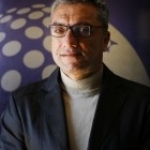The slow heal of wounds in Gaza
Gaza City -- For a few moments, a bullet feels like nothing more than a pin prick. I felt my blood freeze. I saw people screaming and the blood gushing from the newly-formed hole in my leg. But no pain, just a burning bubbling up from my stomach.
I had been a photographer with AFP for nearly 20 years, covering three wars in Gaza as well as conflicts in Libya, Egypt and elsewhere. Through a mixture of good planning and good fortune, I had avoided injury for all those years. But last June, on a crisp Friday afternoon, my luck ran out and an Israeli bullet found me.
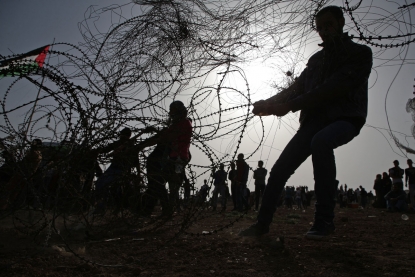 Palestinians try to take down a section of barbed wire at the border fence with Israel during a protest on April 13, 2018. (AFP / Mohammed Abed)
Palestinians try to take down a section of barbed wire at the border fence with Israel during a protest on April 13, 2018. (AFP / Mohammed Abed)By that day, Palestinians had been protesting along the Gaza-Israel border for three months. Starting in late March, thousands would gather every week a few hundred metres from the border calling on Israel to end the blockade of the strip.
Usually smaller numbers of mostly younger men would approach the border, some trying to break the barbed wire fence. Israeli snipers opened fire. Around 100 had been killed by then (it is now more than 200), with thousands of others maimed.
Graphic image
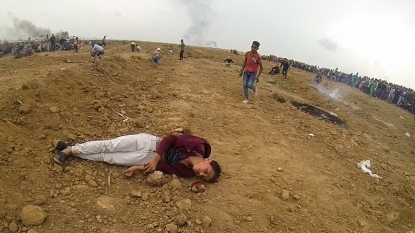 The body of 15-year-old Palestinian teenager Mohammed Ibrahim Ayoub after he was shot and killed by Israeli security forces during clashes along the Israel-Gaza border, April 20, 2018. (AFP / Abed Abu Riash)
The body of 15-year-old Palestinian teenager Mohammed Ibrahim Ayoub after he was shot and killed by Israeli security forces during clashes along the Israel-Gaza border, April 20, 2018. (AFP / Abed Abu Riash)
It was my twelfth Friday in a row covering the protests. Myself and AFP’s two other photographers in Gaza split ourselves between the five protest sites. Jabalia in northern Gaza was my territory.
That day numbers were lower than previous weeks due to the Holy Muslim month of Ramadan.
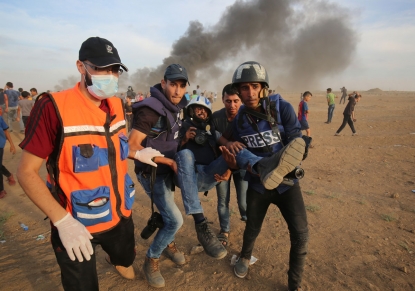 Palestinian paramedics and journalists carry a wounded fellow journalist during clashes with Israeli forces east of Gaza City, along the Gaza-Israel border in the Gaza Strip on October 5, 2018. (AFP / Said Khatib)
Palestinian paramedics and journalists carry a wounded fellow journalist during clashes with Israeli forces east of Gaza City, along the Gaza-Israel border in the Gaza Strip on October 5, 2018. (AFP / Said Khatib)I was wearing my press vest and helmet. A few hundred metres from the border, I felt I was far enough to be safe. I was standing with a group of medics and we were joking. We took a selfie. It was a routine Friday.
Then a crack. A protester tumbled to the ground a few dozen metres ahead. We rushed forward brandishing our tools – them a stretcher, myself a camera.
Then a second. The bullet entered my right leg, passing straight through and grazing the left. I looked down. My beige trousers began to change hue.
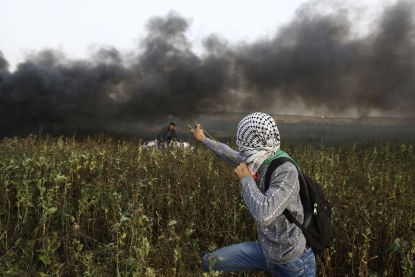 A Palestinian protester uses a slingshots to throw stones towards Israeli forces during clashes following a protest along the border with Israel, east of Gaza City on April 5, 2018 (AFP / Mohammed Abed)
A Palestinian protester uses a slingshots to throw stones towards Israeli forces during clashes following a protest along the border with Israel, east of Gaza City on April 5, 2018 (AFP / Mohammed Abed)I had seen enough people shot to know what to look for. The bullet had missed the knee and I could still wiggle my toes, meaning nerve endings were intact. Relatively, I had been lucky.
With the adrenalin still holding back the pain, I thought of my two loves -- family and photography.
I called out for my camera, tossed away in the melee. We weren’t to be reunited for several days.
Then I grabbed my phone. Every week my wife and daughter had begged me to be careful on the border. I suddenly thought of how they would feel when they heard. “I was shot but I am fine,” I typed out rapidly, as I was loaded onto an ambulance.
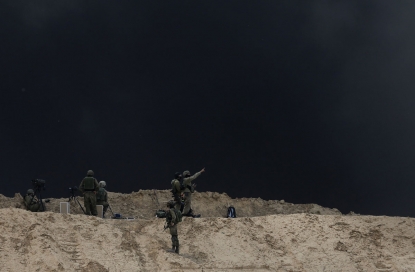 Israeli security forces are deployed near Kibbutz Nir Oz on the Israeli border with the southern Gaza Strip as smoke billows from tyres burning in the Palestinian village of Khuzaa on April 6, 2018. (AFP / Menahem Kahana)
Israeli security forces are deployed near Kibbutz Nir Oz on the Israeli border with the southern Gaza Strip as smoke billows from tyres burning in the Palestinian village of Khuzaa on April 6, 2018. (AFP / Menahem Kahana)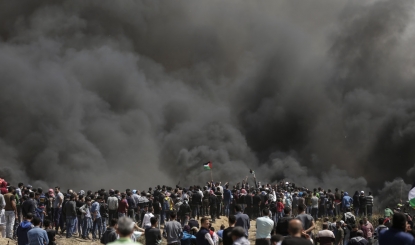 Palestinian men wave their national flags as smoke billows from burning tyres at the Israel-Gaza border during a protest, east of Gaza City in the Gaza strip, on April 6, 2018. (AFP / Mahmud Hams)
Palestinian men wave their national flags as smoke billows from burning tyres at the Israel-Gaza border during a protest, east of Gaza City in the Gaza strip, on April 6, 2018. (AFP / Mahmud Hams)
Ideally I would have gone straight to Israel or outside for treatment as Gaza’s healthcare system was at breaking point. But like almost all Gazans I didn’t have an Israeli permit to leave.
Instead they rushed me to a hospital in Gaza City. Colleagues, family and friends gathered, with doctors operating the same day.
The days after were a blur of operating theatres, visitors and agony.
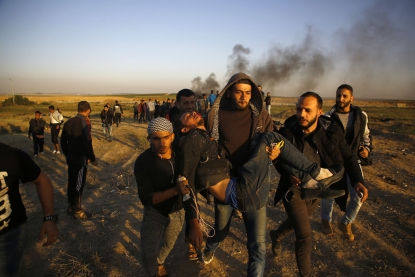 Palestinian protesters carry an injured comrade during clashes with Israeli forces following a protest along the border with Israel, east of Gaza City on April 1, 2018. (AFP / Mohammed Abed)
Palestinian protesters carry an injured comrade during clashes with Israeli forces following a protest along the border with Israel, east of Gaza City on April 1, 2018. (AFP / Mohammed Abed)I eventually got an Israeli permit two weeks later and travelled to Jerusalem for treatment. My wife and I stayed a few weeks, but worried about the kids and eventually returned to Gaza.
It was then, after the initial mayhem subsided, that I began my slow crawl back to life.
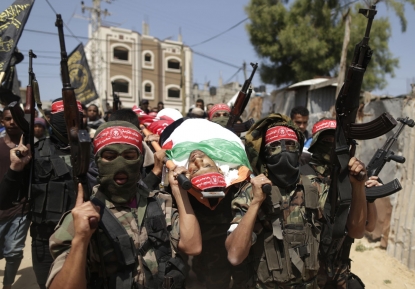 Palestinian militants carry the body of 25-year-old Ahmed Arafa during his funeral in the city of Deir al-Balah, in the centre of the Gaza Strip on April 4, 2018. (AFP / Mahmud Hams)
Palestinian militants carry the body of 25-year-old Ahmed Arafa during his funeral in the city of Deir al-Balah, in the centre of the Gaza Strip on April 4, 2018. (AFP / Mahmud Hams)At first I didn’t sleep well. Israeli airplanes are a fact of life in Gaza and with the spectre of another war constantly hanging over our heads, I was petrified that something would happen and I wouldn't be able to protect myself or run away.
I would wake up abruptly from vivid nightmares in which my whole leg had been amputated. For a while my son Osama slept in my room, rushing to reassure me.
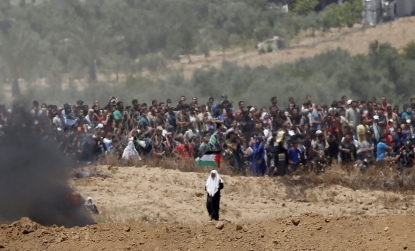 A picture taken on May 14, 2018 from the southern Israeli kibbutz of Nahal Oz across the border with the Gaza Strip shows Palestinian protesters gathering along the border fence with Israel. (AFP / Jack Guez)
A picture taken on May 14, 2018 from the southern Israeli kibbutz of Nahal Oz across the border with the Gaza Strip shows Palestinian protesters gathering along the border fence with Israel. (AFP / Jack Guez)Even when the nightmares abated, I still struggled to sleep. The doctors had installed an external fixation. This is literally a large hunk of metal screwed into your bone to hold the healing leg together, but it means you can’t lie on your side. For months any time I accidentally rolled over I awoke in agony.
When political tensions were high I was a ball of stress, then calmer days would allow me to relax, whiling away the evenings playing cards or watching films. I tried to avoid all news, leaving work Whatsapp groups so I could focus on my recovery. I did leg exercises five times a day. Gradually at home I began to feel like my old self again.
But going out in public was different.
I have spent my life capturing reality, watching the world and waiting for the perfect moment.
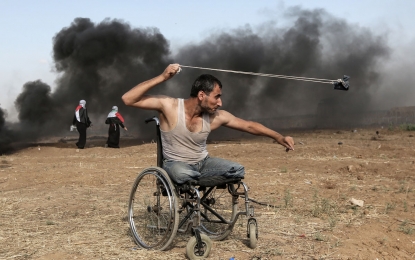 Palestinian Saber al-Ashkar, 29, hurls rocks during clashes with Israeli forces along the border with the Gaza strip, east of Gaza City, on May 11, 2018, as Palestinians demonstrate for the right to return to their historic homeland in what is now Israel. (AFP / Mahmud Hams)
Palestinian Saber al-Ashkar, 29, hurls rocks during clashes with Israeli forces along the border with the Gaza strip, east of Gaza City, on May 11, 2018, as Palestinians demonstrate for the right to return to their historic homeland in what is now Israel. (AFP / Mahmud Hams)Now suddenly I found myself on the other end, being watched as I hobbled around on crutches, viewed as yet another victim of the decades long Israeli-Palestinian conflict.
Conflict has shaped my life, but I don’t define myself as a war photographer -- I see my job as capturing life. In Gaza there isn’t much room for joy, but so often I find it in photography.
After five long months, the external fixation in my leg was removed in October. The metal was unscrewed from the bone, with all the pain that you can imagine.
Doctors tell me the leg will never be as strong as before. But in a month or so my leg and I will finally go back to work and yes, even to the border protests, more aware than ever that there isn’t a single picture that’s worth your life.
This blog was written with Joe Dyke in Jerusalem
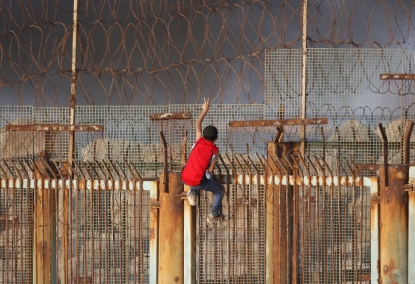 A young Palestinian protestor climbs a fence during a demonstration on the beach near the maritime border with Israel, in the northern Gaza Strip, on October 8, 2018. (AFP / Said Khatib)
A young Palestinian protestor climbs a fence during a demonstration on the beach near the maritime border with Israel, in the northern Gaza Strip, on October 8, 2018. (AFP / Said Khatib)


